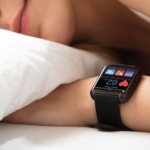Current Research
The researchers are now looking more closely to sort out association and causation, and determine how to use these data to engage patients. Patients wear sensors and can track their steps compared with the steps taken by others. The hope is they will be motivated to walk more after their procedures.
“If they can walk,” Dr. Spiegel said, “the idea is to engage them as much as possible.”
The hospital has also created an app in which patients can walk the hallways to see Cedars-Sinai’s collection of modern artworks, tapping each piece’s number to hear about it.
They are also studying the benefits of remotely monitoring a rich array of data, including biomarkers collected through a pinprick patients can perform themselves, along with physical activity information and psychometrics.
Dr. Spiegel’s hospital has seen benefits using virtual reality as well, immersing patients in soothing beach scenes and other environments, he said. A study of 50 patients found a small but statistically significant pain reduction—a reduction greater than that seen in patients who watched just a two-dimensional relaxation video.3
The insights into what works and what doesn’t have evolved even since 2016, when Cedars-Sinai invited all of its 80,000 patients to connect their smartphone HealthKit data into the hospital’s electronic health record. Only about 500 patients—less than 1%—chose to do so.4
Bottom Line
The mere existence of health technology doesn’t mean there will be participation, let alone benefits, Dr. Spiegel said, adding that the field now poses more of a behavioral science problem than a computer engineering problem.
“First, we have to ask patients what they need,” he said. “Then we need to build the technology to meet those needs. The reverse is likely to fail.”
Thomas R. Collins is a freelance writer living in South Florida.
References
- Noah B, Keller M, Mosadeghi S, et al. Impact of remote patient monitoring on clinical outcomes: An updated meta-analysis of randomized controlled trials. Digital Medicine. 2018 Jan.
- Gresham G, Hendifar A, Spiegel B, et al. Wearable activity monitors to assess performance status and predict clinical outcomes in advanced cancer patients. Digital Medicine. 2018 Jul.
- Tashjian VC, Mosadeghi S, Howard AR, et al. Virtual reality for management of pain in hospitalized patients: Results of a controlled trial. JMIR Ment Health. 2017 Mar 29;4(1):e9.
- Pevnick JM, Fuller G, Duncan R, et al. A large-scale initiative inviting patients to share personal fitness tracker data with their providers: Initial results. PLoS One. 2016 Nov 15;11(11):e0165908.


